Aluminum Foil Boats: Doing Fun Science at Home during School Closures (Activity #29)
Follow along with a Science Buddies parent who is using family STEM activities to keep her kids learning at home during the COVID-19 school shutdown. New posts every Monday, Wednesday, and Friday. Today's adventure... building, floating, and sinking aluminum foil boats.
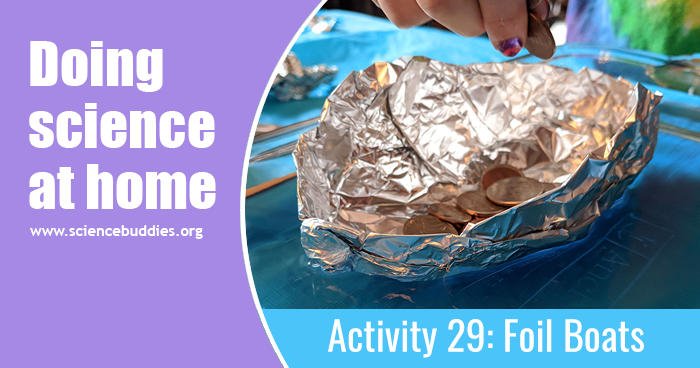
Sinking and Floating Science
We used to have an army of rubber duckies and other bath toys. Sometimes it felt like the toys took up more of the tub than the kids did! Those days are (mostly) gone now, but I doubt it was a unique situation. Whether something sinks or floats is a question kids grasp and are fascinated by at a very young age, and bath toys are often a favorite item for exploring the question. For toddlers, the resulting experiment consists of throwing items into the bathtub, or into puddles, pools, or other bodies of water, and observing what happens. This is a totally age-appropriate experiment!
While I no longer have any toddlers at home, I find that my kids (second and seventh grade) are not done experimenting with floating as a concept — their questions and experiments have just gotten more sophisticated. The question has changed from "Does it float?" to "Why does it float?" and "Can I build it to float?". Here are some activities which are fun and explore floating in ways that make interesting real-world connections for elementary age children and older:
- How Much Weight Can Aluminum Foil Boats Float?: explore what it takes to make an aluminum foil boat float and find out how much weight it can carry.
- How Fish Sink and Float: ever wondered how fish rise and sink to different water levels? This activity gives a hands-on demonstration.
- Does Wet Hair Float or Cling?: it seems like a simple question, but there's a lot more science to how hair behaves around water than you might guess!
- Make a Toy Sailboat: building a cork sailboat is very simple, but it may take a little experimenting to get your boat to sail straight — there's a science trick to it!
- Make Your Drawings Float!: explore how the properties of materials determine whether or not they float.
My Pick of the Day: Building and Sinking Aluminum Foil Boats
A couple of weeks ago, we had a fun time building wire water striders and exploring how they float. While both of my kids enjoyed the activity and succeeded in getting their water striders to stand on top of the water, it was clear that the activity was better suited for my son who is older and has more patience. This time, I wanted an activity that would allow my second-grade daughter to explore floating more, so I chose the How Much Weight Can Aluminum Foil Boats Float?.
The activity involves building different types of boats out of aluminum foil and getting a working idea of what buoyancy and density are by measuring the volume of the boats and connecting that with how much weight the boats can hold. I knew my daughter would love building the different boats and exploring how much weight they could carry, but I also knew that the volume and density calculations are above where she is in math (in Common Core math, second graders have not yet learned division). So, I modified the activity. I got rid of the volume aspect and focused on the actual boat building and on gaining an intuitive (as opposed to mathematical) understanding of the relationship between volume and the mass an object can carry without sinking (which is the conceptual basis for buoyancy and density).
Tip: You know your child best. If you think they'll enjoy one part of an activity but not another, you can always modify the activity! This approach also helps when you have children of different ages or abilities. One child can do a harder version while the other is exploring the same concept in a simplified, age-appropriate manner.
We started by measuring and cutting several equal-size pieces of aluminum foil in order to make several different boat designs. As my daughter worked on making her first boat, we talked about what features she thought might make a boat that was good at holding a lot of coins. In the discussion, I was surprised to hear her talk about making designs that were heavier verses lighter. I realized that she hadn't quite made the connection between the fact that if we start with the same size pieces of aluminum foil, the boats will all be the same weight. So, out came the scale! As she built each boat, she then weighed them, and it didn't take long for her to be able to make the connection and see that if the boats all use the same quantity of starting materials, they will all be the same weight once built.
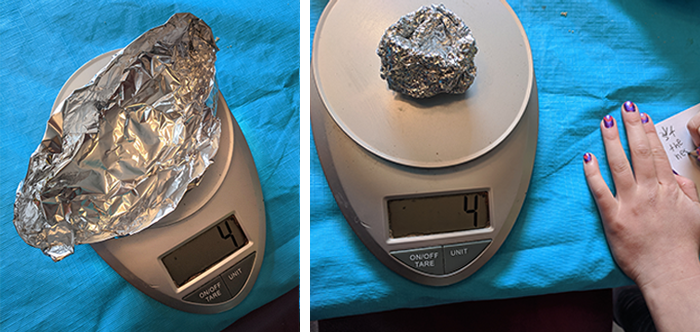
In total, she made four boat designs. Two of these she referred to as "nests," a large diameter one with a larger hollow space and a smaller more compact one. She also made a wide rowboat-like one and a long skinny canoe (these two are shown below).
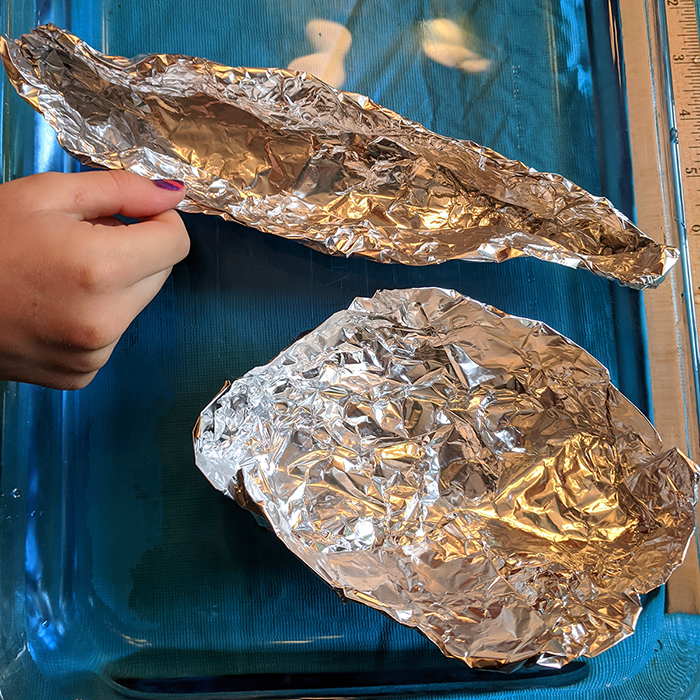
She floated each in a Pyrex (glass) dish full of water. If we do this again, I would use something deeper so that it is easier to see the boats sink — probably the bathtub. But since my kids are learning how to clean in home-quarantine-school, and their tub-scrubbing efforts aren't ready for photo documentation yet, we stuck with the Pyrex dish this time.
All the boats passed the initial float test. Then it was time for the best part — loading them up till they sank! She added coins to each one, carefully looking for signs of distress and calling out warning signs like an overzealous coast guard recruit. Some designs, like the small nest, only took a coin or two to sink, while the rowboat took a surprisingly large number.
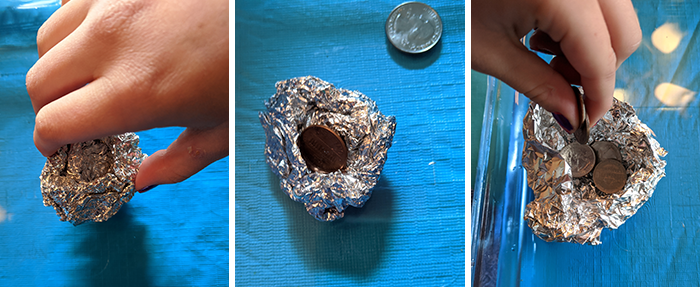
After sinking the boats, she weighed the coins that sank each of her boats, and we discussed how much hollow space had been inside each type of boat. It didn't take her long to see the connection!
Overall, this was a highly successful activity and had a great balance of play and science. If my son had joined us, I would have had him do the full calculations, but at the second-grade level this adaptation was perfect.
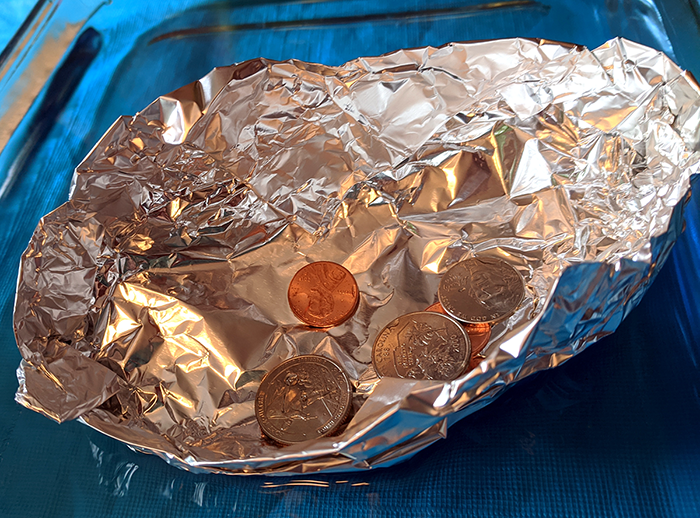
If your kids enjoy building boats or exploring questions about boat design, sinking, and floating, be sure and bookmark this collection of 13 Boat and Submarine Science Projects and Experiments. These ideas might inspire a future family science adventure or school science or science fair project!
If your kids build aluminum foil boats or try any of the other floating activities, we'd love to see. Post a picture of what they make on social media and tag us. You can find us on Twitter, Facebook, and Instagram.
If this blog post was useful to you, please share it with other parents. Follow the links below to see what other science adventures we've been having at home.
View All Posts in this Series
- Activity 1 - Getting Started and Hand Washing
- Activity 2 - Taking Flight with Kites
- Activity 3 - Candle Seesaw and Fire Science
- Activity 4 - Dissecting Flowers
- Activity 5 - Building a Toy Parachute
- Activity 6 - Paper Marbling
- Activity 7 - Shaping Hard-boiled Eggs
- Activity 8 - Invisible Ink
- Activity 9 - Robot Hand
- Activity 10 - Plastic Egg Rockets
- Activity 11 - Rubber Band Guitar
- Activity 12 - Making Model Viruses
- Activity 13 - Air Cannons
- Activity 14 - Balancing an Art Mobile
- Activity 15 - Gumdrop Geometry
- Activity 16 - Solar Updraft Tower
- Activity 17 - Cotton Ball Launcher
- Activity 18 - Wire Water Striders
- Activity 19 - Ice Cream in a Bag
- Activity 20 - Wind-powered Sail Cars
- Activity 21 - Curling Metal
- Activity 22 - Popsicle Stick Catapult
- Activity 23 - Candy Diffusion
- Activity 24 - STEM Videos
- Activity 25 - Making Slime
- Activity 26 - Straw Siphon
- Activity 27 - Elephant Toothpaste
- Activity 28 - Balloon Hovercraft
- Activity 29 - Aluminum Foil Boats
- Activity 30 - Wall Marble Run
A science activity log is available as a Word document or as a Google doc for online convenience. (Just choose "File/Make a copy" to save it to your Google Drive.)
About the Author
Sandra, Science Buddies' Vice President of STEM education, holds a PhD in Genetics from Stanford University and has spent the last twelve years working on science education and STEM outreach. Right now, she's stuck working from her home in the Pacific Northwest with her husband, second grader, middle schooler, and two oddly noisy gerbils. She hypothesizes her sanity will hold as long as she gets a daily dose of sunshine.
Categories:
You Might Also Enjoy These Related Posts:
- Wall Marble Run: Doing Fun Science at Home during School Closures (Activity #30)
- Aluminum Foil Boats: Doing Fun Science at Home during School Closures (Activity #29)
- Hovercraft: Doing Fun Science at Home during School Closures (Activity #28)
- Elephant Toothpaste: Doing Fun Science at Home during School Closures (Activity #27)
- Straw Siphon: Doing Fun Science at Home during School Closures (Activity #26)
- Slime Three Ways: Doing Fun Science at Home during School Closures (Activity #25)
- A STEM Videos Breather: Doing Fun Science at Home during School Closures (Activity #24)
- Candy Experiments: Doing Fun Science at Home during School Closures (Activity #23)









